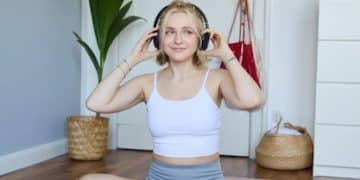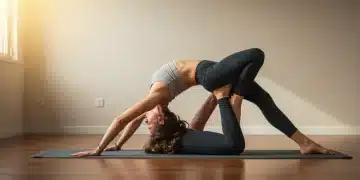Yoga for Beginners: Master Poses in 4 Weeks
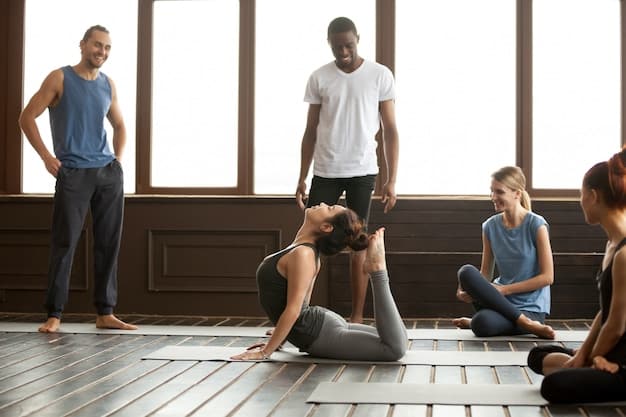
Yoga for Beginners: A Practical Guide to Mastering the Foundational Poses in 4 Weeks provides a structured four-week plan with pose breakdowns, modifications, and tips for building a consistent yoga practice, making it accessible and enjoyable for newcomers.
Embark on your yoga journey with confidence! Yoga for Beginners: A Practical Guide to Mastering the Foundational Poses in 4 Weeks is designed to provide you with a clear, progressive path to developing a fulfilling and sustainable yoga practice.
Why Yoga is Great for Beginners
Yoga offers a wealth of benefits for beginners. It’s not just about flexibility; it improves strength, balance, and mental well-being. For many, yoga can seem intimidating, but with the right approach, it’s incredibly accessible.
It can be a powerful tool for stress reduction and improving overall quality of life.
Physical Benefits of Yoga
Yoga enhances physical health in multiple ways. It can improve flexibility, increase strength, and boost cardiovascular health. Consistent practice can lead to better posture and balance.
- Improved Flexibility: Yoga stretches muscles, promoting better range of motion.
- Increased Strength: Holding poses builds muscle strength and endurance.
- Better Balance: Yoga poses challenge and improve balance, reducing the risk of falls.
- Enhanced Posture: Strengthening core muscles improves posture and spinal alignment.
These physical improvements contribute to a greater sense of body awareness and control.
Mental Benefits of Yoga
Beyond the physical, yoga profoundly impacts mental and emotional health. It’s a form of active meditation that reduces stress and enhances mindfulness. Regular practice can improve focus and mental clarity.
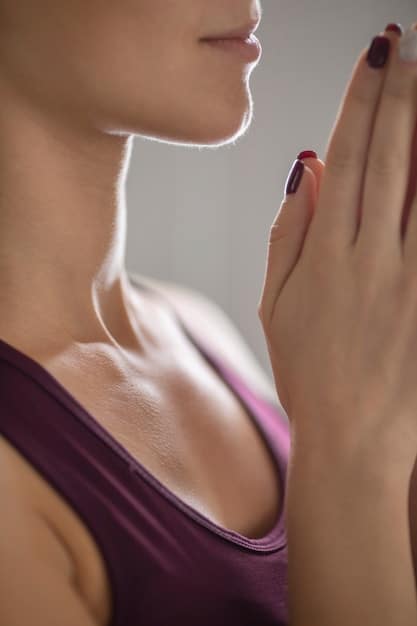
Yoga teaches individuals to notice their thoughts and feelings without judgment.
By focusing on the present moment, practitioners can reduce anxiety and stress.
In conclusion, yoga’s benefits extend far beyond the mat, offering a holistic approach to health.
Setting Up Your Yoga Space and Gear
To begin your yoga journey, you need to create a suitable space and gather essential gear. A calm and quiet environment can significantly enhance your practice. The right gear can make your practice more comfortable and effective.
You don’t need a lot of fancy equipment to get started.
Creating a Peaceful Environment
Your yoga space should be free from distractions. Choose a room or area where you can practice undisturbed. Soft lighting and a comfortable temperature create a welcoming atmosphere.
Adding plants or calming decor can help establish a serene environment.
Minimizing clutter and noise ensures a peaceful and focused practice.
Essential Yoga Gear
While you don’t need much, a few key items can enhance your yoga experience. A good yoga mat is essential for providing grip and cushioning. Other helpful items include blocks and straps to assist with poses.
- Yoga Mat: Provides a non-slip surface and cushioning for joints.
- Yoga Blocks: Help with alignment and making poses more accessible.
- Yoga Strap: Aids in stretching and extending reach in certain poses.
Comfortable, breathable clothing allows for ease of movement.
Having these essentials ready can make your practice more enjoyable and safe.
In summary, a well-prepared space and basic gear set the stage for a successful practice.
Week 1: Foundational Poses and Breathing Techniques
Week one focuses on familiarizing yourself with foundational poses and breathing techniques. These are the building blocks of your yoga practice. Mastering these basics sets the stage for more advanced poses in the coming weeks.
The goal is to build a solid foundation and establish good habits.
Mountain Pose (Tadasana)
Mountain Pose is the foundation for all standing poses. It teaches proper alignment and grounding. Stand tall with your feet hip-width apart, engaging your muscles from your feet to your head.
- Stand tall with feet hip-width apart.
- Engage your leg muscles and core.
- Draw your shoulders back and down.
- Lengthen your spine and lift the crown of your head toward the ceiling.
Focus on your breath and maintain a steady gaze.
Downward-Facing Dog (Adho Mukha Svanasana)
Downward-Facing Dog is a versatile pose that stretches and strengthens the entire body. Start on your hands and knees, then lift your hips up and back, forming an inverted V-shape. Keep your spine long and your heels reaching toward the floor.
This pose can relieve stress and mild depression.
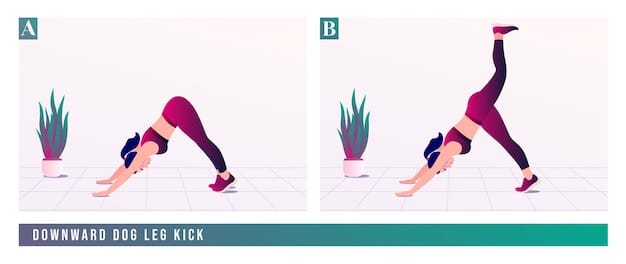
Modify by bending your knees if needed.
In conclusion, week one introduces essential poses and breathwork to start your yoga journey.
Week 2: Building Strength and Flexibility
Week two builds on the foundational poses. The focus is on deepening your practice and increasing strength and flexibility. Incorporating new poses and holding them for longer durations enhances the benefits.
Continue practicing the poses from week one to reinforce your foundation.
Warrior I (Virabhadrasana I)
Warrior I strengthens the legs, core, and arms. It also improves balance and concentration. Step one foot forward into a lunge, keeping your front knee aligned over your ankle. Raise your arms overhead, palms facing each other. Square your hips to the front.
Visualize strength and confidence.
Hold the pose for several breaths.
Plank Pose (Phalakasana)
Plank Pose strengthens the core, arms, and legs. Start in a push-up position with your body in a straight line from head to heels. Engage your core and maintain a neutral spine. Avoid letting your hips sag.
This pose builds endurance and stability.
Engage your core to prevent lower back strain.
In summary, week two focuses on building strength and flexibility through key yoga poses.
Week 3: Balance and Core Engagement
Week three introduces poses that challenge balance and engage the core. These poses improve stability, focus, and body awareness. Practicing balance poses enhances coordination and mental concentration.
Engaging your core is essential for maintaining stability.
Tree Pose (Vrksasana)
Tree Pose improves balance and focus while grounding you. Stand tall and place the sole of one foot on your inner thigh, avoiding your knee. Bring your hands to prayer position at your chest or extend them overhead. Find a focal point to maintain balance.
- Focus on a non-moving object.
- Engage your core to stabilize your body.
- Breathe deeply and evenly.
Visualize yourself as a strong, rooted tree.
Boat Pose (Navasana)
Boat Pose strengthens the core and improves balance. Sit with your knees bent and feet lifted off the ground. Extend your arms forward, parallel to the ground. For a greater challenge, straighten your legs. Keep your spine straight and your chest lifted.
This pose builds core strength and mental focus.
Modify by bending your knees if needed.
In conclusion, week three focuses on balance and core engagement for enhanced stability and focus.
Week 4: Relaxation and Sustaining Your Practice
Week four emphasizes relaxation and sustaining your yoga practice. Incorporating restorative poses and mindfulness techniques promote relaxation and stress reduction. Establishing a consistent routine ensures long-term benefits.
Yoga is a journey, not a destination.
Corpse Pose (Savasana)
Corpse Pose is the ultimate relaxation pose. Lie on your back with your arms at your sides, palms facing up. Close your eyes and release all tension in your body. Focus on your breath and allow yourself to fully relax. Savasana allows the body and mind to integrate the benefits of the practice.
- Close your eyes and release all tension.
- Focus on your breath.
- Allow yourself to fully relax.
This pose quiets the mind and reduces stress.
Mindfulness and Meditation
Mindfulness and meditation enhance the benefits of your yoga practice. Practicing mindfulness involves paying attention to the present moment without judgment. Meditation techniques such as breath awareness and body scans promote relaxation and mental clarity.
Mindfulness can be practiced anytime, anywhere.
Even a few minutes of mindful breathing can reduce stress.
In summary, week four focuses on relaxation, mindfulness, and creating a sustainable yoga practice for long-term well-being.
| Key Point | Brief Description |
|---|---|
| 🧘♀️ Foundational Poses | Master Mountain Pose, Downward Dog and more. |
| 💪 Strength & Flexibility | Build up with Warrior I and Plank Pose. |
| 🌳 Balance & Core | Improve stability with Tree and Boat Pose. |
| 😌 Relaxation | End your practice with Corpse Pose and mindfulness. |
FAQ
▼
Beginners should aim to practice yoga 2-3 times per week. This frequency allows your body to adjust and benefit without overexertion, gradually building strength and flexibility.
▼
Wear comfortable, breathable clothing that allows for a full range of motion. Avoid restrictive clothing that can hinder movement. Yoga pants and a fitted top are ideal choices.
▼
No, you don’t need to be flexible to start yoga. Yoga is about progress, not perfection. Regular practice will gradually increase your flexibility. Start where you are and modify poses as needed.
▼
Yes, but it’s important to consult with your healthcare provider before starting. Modify poses or seek guidance from a qualified yoga instructor who can adapt the practice to your needs.
▼
It’s perfectly fine to modify poses or take breaks. Start by holding poses for a few breaths and gradually increase the duration as you become stronger and more comfortable. Listen to your body.
Conclusion
Starting your yoga journey as a beginner can be a transformative experience. With a structured four-week plan, focus on **Yoga for Beginners: A Practical Guide to Mastering the Foundational Poses in 4 Weeks**, proper alignment, and consistent practice, you’ll be well on your way to enjoying the physical and mental benefits of yoga. Embrace the process, listen to your body, and celebrate your progress every step of the way.



